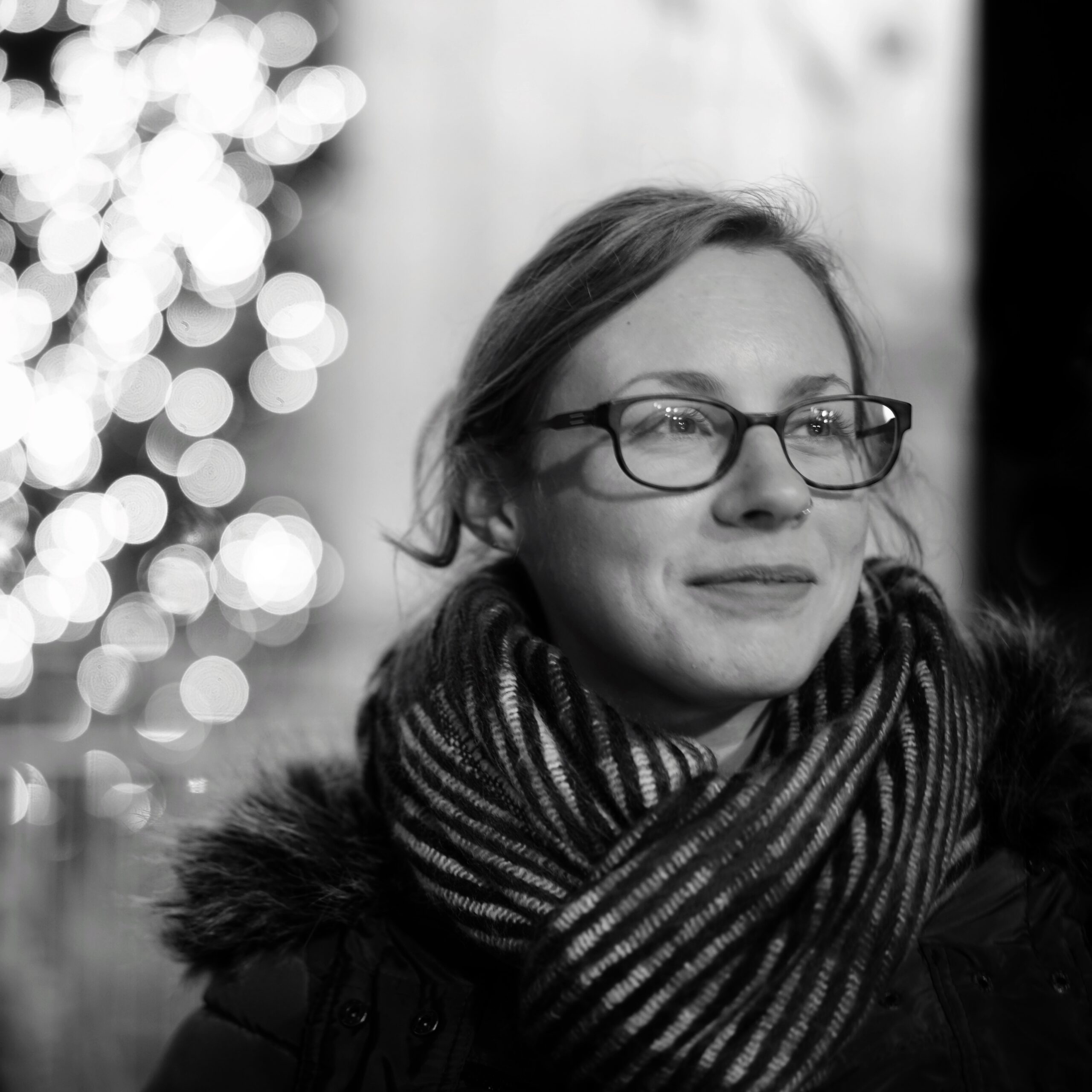
by Erin Calabria
The first time I heard the world through a field recorder, it was like falling into a parallel dimension. Here was another universe rubbing shoulders with ours, where everything looked the same but sounded completely different. Ears cocooned in heavy foam headphones, I slowly rotated the levels to pull this alternate reality nearer, then push it away. It was quieter here in this dimension, swept clean of distant noise, pared down within the microphone’s range. And yet its closeness was also almost overwhelming—so intricate, so intimate—the smallest buzz of fluorescent lamps or whirr of fan blades or crinkle of paper suddenly leaping out crisp and clear. It reminded me of nothing so much as the heightened otherworld of a book.
The first story I recorded was from a man who, at fifty-four years-old, had just met his birth mother. We sat at his kitchen table, the windows around us aglow with the reflected brightness of hard-packed snow outside. I held the microphone while he told me about the former home for unwed mothers in town, how he had found his birth mother’s high school yearbook photo at the local library, how he had her eyes.
Back then, I hadn’t yet read the poem by Louise Glück that says, “everything returns, but what returns is not / what went away.” It would have made sense to this man, I think, and to his birth mother, who would later tell me how she missed his growing up, how she wanted so much to be able to rock this son who was now too grown for rocking.
Back then, I didn’t know if I would ever be able to write any stories. I had gotten lost somehow with my own words, the blank page a world I didn’t know how to enter. But I knew there were also stories all around, traces of them shivering through every air current. So, I decided to learn how to tell stories through sound.
At radio documentary school, I learned that crafting an audio story entails innumerable returns: there are hours of tape to transcribe, rough cut, log, and draft into scripts, there is narration to record and re-record, edits and fades and music to layer and fine-tune. Eventually, the story begins to feel less like a linear flow of sound and more like strata formed not out of geological rock but out of voices. Together, those voices stack and braid into a new architecture, one that both recalls and recasts everything each individual voice first spoke alone. Returning—transforming—all at once.
Still, producing an audio story doesn’t just depend on deliberate effort and revision. During production, the precise words included might be dictated not by sense but by sound—its shifts in volume, upward and downward inflection, trailing or interrupted sentences—all of which remain outside the control of a producer striving to smooth abrupt cuts or tonal inconsistencies, to chart the rhythm of breath. But even before production, there is always an element of the unknown, of spontaneous revelation; while radio school taught me how to plan interview questions, how to sequence and follow them up, any conversation with another human being leads to intriguing tangents, unexpected truths.
On a second winter afternoon, I returned to the man’s kitchen with my microphone. This time the snow was deeper, and he was tired. Of me, maybe, of the temporary but emotional intrusion I’d made into his and his birth mother’s lives. I let the interview end earlier than a seasoned journalist might, but I kept the recorder running the whole time I was there, as I’d said I would, and told him a story instead. And then, in that free, unplanned space, the man revealed to me one of the hardest but truest things he ever did: no matter how much you might wish that two long-separated families could be one, all together, unriven, it’s just not that way.
If I’m honest, I can’t be sure everything returns. But sometimes I think maybe that’s just another way of saying that we aren’t here in vain. That we aren’t alone. These days, I see the companion forces of deliberate effort and spontaneous revelation in my writing process, as well as in craft discussions from other writers. I see them in George Saunders’ observation that “a beautiful story” emerges as “the culmination of a series of revisions. That is: a good story occurs in waves,” and in his advice to “[k]eep coming back to [a rough patch] with affection and hope, until it relents and pops into clarity.” And I see those forces in Philip Pullman’s daily three-page routine, in his experience of writing as “a mysterious process” that “feels like discovery […] rather than invention.”
Back then, when I was making an audio story for the first time, I didn’t know all this. But I was learning as I listened, as I shuffled and slipped sections of tape across multiple tracks, adjusting volume and pace, forgetting myself as I returned again and again to the story. Through sound, I was learning what some writers do through color-coding or rearranging cut-out paragraphs on the floor: I was learning to think of the story as a kind of three-dimensional montage, with parts that didn’t inherently belong in any linear order but that could be mixed and moved, expanded and trimmed down. And though I wouldn’t have been able to articulate it at the time, I was also learning how a story assumes its own being, how it shifts and asserts itself beyond the person shaping it. As Sheila Heti puts it: “If my book is art, a work of art is not the artist talking to you. It is a separate form. It is its own self […].”
Of course, this is not to absolve the storyteller of responsibility; much of radio school also involved learning how to navigate issues of journalistic ethics and access, how to consider the comfort and privacy of a story’s subjects while still seeking depth and “good tape.” It involved learning how to identify storytelling components, to map moments of action, background, development, reflection, tension, digression. And while these tools helped me take responsibility for the ethical and narrative impact of the story, they also placed the story itself—and the voices within it—first. They acknowledged the story and those voices as their own selves.
For years, birth mother and son sent me text messages each Christmas, and I would picture them as they had been limned in snowlight, I would hear their voices as they had filtered rich and clear through the microphone. And though it has been quite some time since I’ve held a field recorder or stitched a story out of sound, I think of them both often when I write, about how their words led me back to the ones I type now. And sometimes, I recall another poem by Louise Glück that says: “[…] whatever / returns from oblivion returns / to find a voice.”
These days, I still don’t always know how to enter the otherworld of the book I’m writing now. It’s a book that, back then, I never thought I’d be able to write. But I keep returning to it, again and again, and slowly, the book keeps taking shape: deliberately, spontaneously, becoming itself.
Sources/Further Reading:
Glück, Louise. “The Wild Iris.” The Wild Iris. Ecco, 1992, p. 1.
Glück, Louise. “Denial of Death.” Winter Recipes from the Collective. Farrar, Straus and Giroux, 2021, pp 5-11.
Gomperz, Will and Lauren Turner. “Philip Pullman: Rules of writing from man behind His Dark Materials.” BBC News, 19 Oct. 2017, www.bbc.com/news/entertainment-arts-41670890.
Naimon, David, host. “Sheila Heti: Pure Colour.” Between the Covers, Tin House, 1 Apr. 2022, www.tinhouse.com/podcast/sheila-heti-pure-colour/.
Saunders, George. “George Saunders on Overcoming Uncertainty in Writing.” Lit Hub, 25. Feb. 2022, www.lithub.com/george-saunders-on-
Read more of Erin’s work here at Reckon:
Fiction – Lampyridae
Nonfiction – Soundscapes: Story as a Place to Dwell

